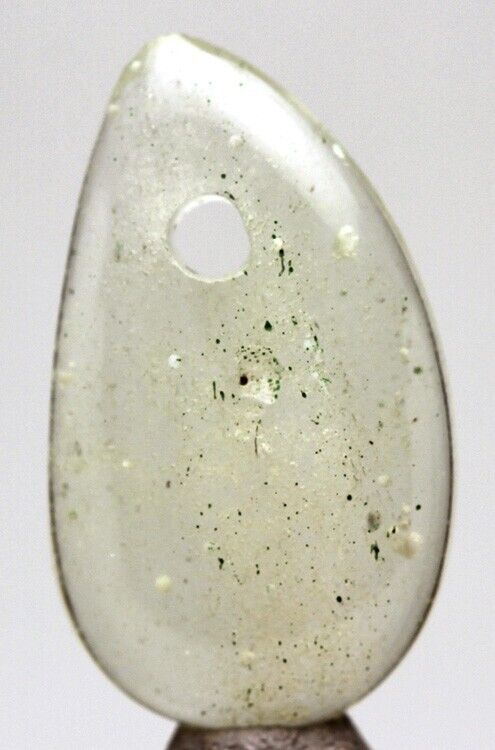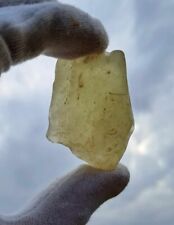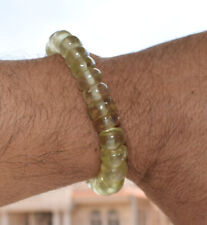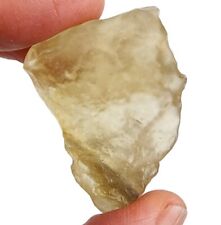LIBYAN DESERT GLASS CARVING CABOCHON METEORITE IMPACTITE TEKTITE GEMSTONE EGYPT For Sale

When you click on links to various merchants on this site and make a purchase, this can result in this site earning a commission. Affiliate programs and affiliations include, but are not limited to, the eBay Partner Network.
LIBYAN DESERT GLASS CARVING CABOCHON METEORITE IMPACTITE TEKTITE GEMSTONE EGYPT:
$49.99
This gemstone weighs 5.50 carats, which is 1.10 grams. It measures 21 mm x 12 mm x 3 mm.I offer a shipping discount for customers who combine their payments for multiple purchases into one payment!The discount is regular shipping price for the first item and just 50 cents for each additional item!
To be sure you get your shipping discount just make sure all the items you want to purchase are in your cart.
sales you win are added to your cart automatically.
For any \"buy it now\" items or second chance offers, be sure to click the \"add to cart\" button, NOT the \"buy it now\" button.
Onceall of your items are in your cart just pay for them from your cart andthe combined shipping discount should be applied automatically.I offer a money back guarantee on every item I sell.
If you are not 100% happy with your purchase just send me a message to let me know
and I will buy back the item for your full purchase price.This is a very nice, and highly translucent flat carved cabochon of Libyan Desert Glass. If you don\'t know what that is, well then get ready to be amazed! This was formed from an ancient meteorite explosion over the middle of the Libyan Desert in Egypt. The heat of the explosion melted the sand and it cooled into this beautiful yellow glass! It is highly collectible and more and more rare all the time. It it getting more difficult to find and I was just selling some stuff that I had in an old collection. So I am offering this beautiful piece foryou. It is really really beautiful, and it what a great present or just to buy for yourself. If you have any questions, do not hesitate to ask me. Thanks so much for visiting my sale and have a great day!
If you purchase from me you should know that the authenticity of this meteorite is guaranteed!
Iam a member of the IMCA or the International Meteorite Collector\'sAssociation. This is an organization that is a check and balance ofthose who collect, trade and sell meteorites. You can only join thisorganization by having the utmost integrity. You must to have two references from existing members to get in and a goodreputation. Members of this organization maintain a highstandard by monitoring each others\' activities for accuracy and honesty. It isevery IMCA member\'s responsibility and pleasure to offer help andassistance to fellow members in order to ensure specimens are genuine. It is not wise to purchase meteorites on or other sources from those who are not IMCA members. This is a verytight-knit community made up of meteorite hunters, dealers, collectors, and scientists who look out for each other to make surethat the meteorites offered to the public are authentic and genuine. I encourage you to visit the IMCA website and getmore information on what being a member means, and how your purchasesfrom its members are guaranteed.
IMCA Member #7446
Below is some information from Wikipedia about Libyan desert glass:
Libyan desert glass
From Wikipedia, the free encyclopedia
Jump to: navigation, searchLibyan Desert GlassLibyan desert glass (LDG), or great sand sea glass is a substance found in areas in the Libyan Desert. Fragments of desert glass can be found over large areas, up to tens of kilometers.Geologic origin
The origin of the glass is a controversial issue for the scientific community, with many evolving theories. Meteoric origins for the glass were long suspected, but recent research linked the glass to impact mechanics, such as vaporized quartz and meteoric metals, and to an impact crater. Some geologists associate the glass not with impact melt ejecta, but with radiative melting from meteoric large aerial bursts. If that were the case, the glass would be analogous to trinitite, which is created from sand exposed to the thermal radiation of a fireball.Tektite
From Wikipedia, the free encyclopedia
Jump to: navigation, search
This article needs additional citations for verification. Please help improve this article by adding reliable references. Unsourced material may be challenged and removed. (October 2008)This article is about impact rocks. For the oceanographic research habitat, see Tektite habitat. For the video game character, see Enemies in The Legend of Zelda series#Tektite.Two tektitesTektites (from Greek tektos, molten) are natural glass rocks up to a few centimeters in size, which most scientists argue were formed by the impact of large meteorites on Earth\'s surface. Tektites are typically black or olive-green, and their shape varies from rounded to irregular.
Tektites are among the \"driest\" rocks, with an average water content of 0.005%. This is very unusual, as most if not all of the craters where tektites may have formed were underwater before impact. Also, partially melted zircons have been discovered inside a handful of tektites. This, along with the water content, suggests that the tektites were formed under phenomenal temperature and pressure not normally found on the surface of the Earth.
A very rare shape of Australite Tektite - Shallow Bowl, next to a coin 24 mm in diameterContents1 Origins1.1 Terrestrial impact theory1.2 Early non-terrestrial impact theories2 Occurrence3 Literature3.1 Books3.2 Articles4 External links
OriginsTerrestrial impact theory
Tektite and Sandstone concretion demonstrate the same shapeThe terrestrial-impact theory states that a meteorite impact melts material from the Earth\'s surface and catapults it up to several hundred kilometers away from the impact site. The molten material cools and solidifies to glass. According to this theory, a meteorite impact causes their formation, but the precursor material of tektites is primarily of terrestrial origin, as determined from isotopic measurements. Today, the terrestrial origin of tektites is widely accepted based on the results of many geochemical and isotopic studies (e.g. Faul H.(1966), Koeberl C.(1990)).
The impact theory relies on the observation that tektites cannot be found everywhere on Earth\'s surface. They are only found in four strewnfields, three of which are associated with known impact craters. Only the largest and geologically youngest tektite deposit in Southeast Asia, called the Australasian strewnfield, has not been definitively linked to an impact site, probably because even very large impact structures are often not easy to detect. For example, since the Chesapeake Bay impact crater (today the largest known impact structure of the United States and associated with the North American tektite strewnfield) is covered by sediments, it was not detected until the early 1990s. Also, the bigger the strewnfield, the bigger the area to search for the crater. Since several new craters are identified every year, this is not really regarded as a problem by proponents of the tektite impact theory, except for the expected Australasian crater, a feature that would be less than a million years old and thus easily visible. This crater, if it exists at all, has not been located.
A moldavite tektiteAn Indochinite tektiteThe ages of tektites from the four strewnfields have been determined using radiometric dating methods. The age of moldavites, a type of tektite found in Czech Republic, was determined to be 14 million years, which agrees well with the age determined for the Nördlinger Ries crater (a few hundred kilometers away in Germany) by radiometric dating of Suevite (an impact breccia found at the crater). Similar agreements exist between tektites from the North American strewnfield and the Chesapeake Bay impact crater and between tektites from the Ivory Coast strewnfield and the Lake Bosumtwi-Crater.
Below are some types of tektites, grouped according to the four known strewnfields, and their associated craters:
European strewnfield (Nördlinger Ries, Germany, age: 15 million years):Moldavites (Czech Republic, green)Australasian strewnfield (no associated crater identified; but see Wilkes Land crater):Australites (Australia, dark, mostly black)Indochinites (South East Asia, dark, mostly black)Chinites (China, black)North American strewnfield (Chesapeake Bay impact crater, USA, age: 34 million years):Bediasites (USA, Texas, black)Georgiaites (USA, Georgia, green)Ivory Coast strewnfield (Lake Bosumtwi Crater, Ghana, age: 1 million years):Ivorites (Ivory Coast, black)
Early non-terrestrial impact theoriesThis article may require cleanup to meet Wikipedia\'s quality standards.Please improve this article if you can. (October 2006)Aerodynamically shaped Australite; the button shape caused by ablation of molten glass in the atmosphere.
Though the meteorite impact theory of tektite formation is widely accepted, minority theories propose alternate ideas of tektite formation.
Tektites contain no cosmogenic noble gases produced by cosmic rays, a factor that excludes long travel in space, necessary if tektites are not terrestrial. According to terrestrial-impact adherents, this makes a lunar origin unlikely, because it is hard to reconcile with finding cosmogenic noble gases in all lunar meteorites – a typical lunar meteorite taking about 1 million years to transfer from Moon to Earth. Furthermore, an origin from the Moon or other body cannot explain why many tektites are only found in confined areas unlike meteorites of lunar or other origin, which are found dispersed on the Earth\'s surface. Whether the Australasian and Ivory Coast tektites fit this thesis is debatable.
In particular, no tektite strewn field exists in Antarctica, where the flow of glaciers would sweep extraterrestrial material away. Since the Australasian strewnfield expands with each new tektite discovered on the southern seafloor, this tektite field may yet be found to reach as far as Antarctica, but regularly undertaken meteorite recovery expeditions in areas that accumulate extraterrestrial material have found only meteorites and no tektites at all. If tektites from space fall in Antarctica, a large part of the recovered material should instead be tektites and an existing strewnfield should already have been discovered. Conversely, the Australasian and Ivory Coast strewnfields have expanded over the decades as new tektites are found in sea sediments; they now reach toward the southern continent. Thus, it may be premature for terrestrial-origin proponents to say that tektites will never be discovered on Antarctica.
According to researchers, measurements of high concentrations of the radionuclide 10Be in tektites from the relatively young Australasian strewnfield are an indication of terrestrial origin. 10Be is produced by cosmic rays in the atmosphere, where it is down-washed by rain and incorporated into young sediment layers. Because 10Be decays with a half-life of about 1.5 million years, its concentration in older sediments and other kinds of rocks appears successively lower. 10Be is found in meteorites and lunar rocks at a concentration lower than that of the young sediments because the cosmic rays interact with these rocks to produce much smaller quantities. Many[citations needed] regard these findings as the final breakthrough for the non-terrestrial impact theory, because they show that the precursor material is mainly terrestrial in origin (mixed with small traces of extraterrestrial material, perhaps that of the impactor). Scientists who claim tektite glasses are impact melts generally ignore[citations needed] their structure (petrography) and high quality. Instead, they base their claims on comparisons of tektite chemistries with the averages of certain sediments, and on certain rare-earth and isotopic values claimed not to exist in the Moon. Other researchers[citations needed], however, have shown that tektite glasses are not really comparable to terrestrial sediments, which have a wide range of chemical variance – especially in the alkalis; and instead often exhibit igneous (volcanic) chemical trends. They also argue the physical impossibility of forming tektites by impact \"jetting\" or \"compression rebound\".
In 1961, officials at the U.S. Air Force\'s Cambridge Research Laboratories in Bedford, Massachusetts, were keenly interested in the chemical and physical characteristics of tektites. \"Project 7698\" was commissioned with W.H. Pinson, Jr. of the Massachusetts Institute of Technology as the principal investigator. The 7698 final report concluded that the strontium isotopic composition of tektites did not match those of terrestrial rocks and impactites. Pinson concluded the theory of formation by random fusion of terrestrial materials \"whether by impact of meteorites, asteroids, comets or lightning\" could not be supported.
It has been shown by researchers working on certain Apollo samples that a number of terrestrial-like rare-earth and isotopic values evidently do exist at depth in the Moon. Such samples have reached the surface in certain volcanic processes. Both terrestrial and lunar volcanism have produced iridium values comparable to that of the KT (Cretaceous/Tertiary) clay/microtektite layer. However, either terrestrial or lunar volcanism can not explain isotopic anomalism found in the KT boundary. In other words, chromium isotopic composition is homogeneous within the Earth-Moon system, so the chromium isotopic anomaly found in the KT boundary can be explained only if material from an impactor (asteroid or comet) were mixed in. Material of lunar origin, discovered to date, cannot explain the isotopic characteristics.
NASA scientist John A. O\'Keefe published numerous papers between the 1950s and 1990s discussing these lunar rare-earth, isotopic and other chemistries, and how they relate to tektite glass.[citation needed]
Thus, some tektite researchers continue to strongly disagree with the popular terrestrial-impact theory; they suggest that tektites are more likely volcanic ejecta from the Moon.
From the 1950s through the 1990s, NASA aerodynamicist Dean R. Chapman and others advanced the \"lunar origin\" theory of tektites. Chapman used complex orbital computer models and extensive wind tunnel tests to support the theory that the so-called Australasian tektites originated from the Rosse ejecta ray of the large crater Tycho on the Moon\'s nearside. Until the Rosse ray is sampled, a lunar origin for these tektites cannot be ruled out. During the 1980s and 1990s, researchers such as O’Keefe of NASA, astronomer and long-time tektite researcher Hal Povenmire, and petrologist Darryl Futrell claimed that the slow way in which tektite glass formed (called \"fining\"), and the volcanic features they claimed to have observed within some layered tektites, couldn’t be explained by the terrestrial-impact theory. Unlike all terrestrial impactite glasses, tektites are nearly free of internal water similar to lunar rocks. Also, Stokes\' Law does not permit the formation of tektites during impact while the velocity needed to form certain \"flanged\" tektites is more compatible with a lunar origin rather than a terrestrial origin. O\'Keefe suggested explosive, hydrogen-driven lunar volcanoes as the original source of tektites. Note: Since the unmanned U.S. Clementine lunar mission of the 1990s, vast areas of pyroclastic (volcanic) glasses have been identified, notably in the area of the Aristarchus plateau. There is also evidence of interstitial granitic material (akin to the acidic tektites in chemistry) in some lunar highland samples which bolsters the lunar-origin theory. Lunar Orbiter spacecraft images reveal fields of volcanic domes that may indicate deep-seated, high-silica eruptions on the Moon, possible sources of the tektites. (These domes are similar to the Mono Lake craters of California; ironically, Mono obsidians resemble some layered tektites).
A part of one of the rock samples collected on Apollo 12, lunar sample 12013, has a composition which is remarkably similar to some tektites. It is especially similar to high-magnesium javenites (part of the Australasian field). Sample 12013 is inhomogenous in that it is composed of two types of materials, light and dark. The light, acidic portion is composed of up to 71 percent silicon dioxide. The dark portion resembles KREEP rocks. The abundances of 20 of 23 elements tested from the acidic portion of the sample showed a striking similarity to high-magnesium tektites. The major elements matched well; the minor and trace elements did not. However, other lunar samples matched some microtektites very well.
Even with great similarity to a tektite, lunar sample 12013 is not generally accepted as a tektite. However, it is similar enough to some tektites that it cannot be ignored.[citations needed] Thus, mineralogist Brian Mason and petrologist W.G. Melson, geologists Edward Chao, Robert J. Foster, and Jack Green – along with astronomers Mark R. Chartrand, Franklyn Branley, J.E. van Zyl, Paolo Maffei and ceramic scientist David Pye – reject the terrestrial-origin theory and support a lunar origin.
Finally, according to O\'Keefe and Povenmire, Apollo 14 lunar sample 14425 resembles some high-magnesium, low silica content microtektites. However, this claim was rejected in a study by scientist B.P. Glass. Regardless, O\'Keefe said that \"If 14425 was found in Antarctica instead of Fra Mauro (on the Moon), it would probably have been accepted as a tektite.\"
While the more visible tektite-origin \"battle\" may have quieted down since the Apollo era, it continues among some serious meteorite researchers and collectors who have studied the topic in depth and refuse to surrender their favorite theory.Occurrence
The Moldau River in the Czech Republic is now the only known locality for green, transparent tektite. The first tektites were found in 1787 in the Moldau River, hence their original name of \"moldavites.\" Other color varieties of this natural glass have since been found in many different localities. Tektites are usually translucent and occur in a range of colors from green to brown. Their surfaces are usually uneven or rough, with a distinctive lumpy, jagged, or scarred texture. Tektites do not contain the crystallites found in obsidian. They may, however, have characteristic inclusions of round or torpedo-shaped bubbles or honeylike swirls. Tektites from Thailand have been carved as small, decorative objects worn in the belief that they give protection from evil.

Related Items:
Libyan Desert Glass 45.33g Meteorite Tektite (226.65 carats) Libyan Gold Tektite
$56.17
Libyan Desert glass Bracelet-28 beads-12mmx6mm-196 ct-Meteorite Tektite-asteroid
$250.00
Libyan Desert Glass from Egypt 13.5 grams
$29.99



